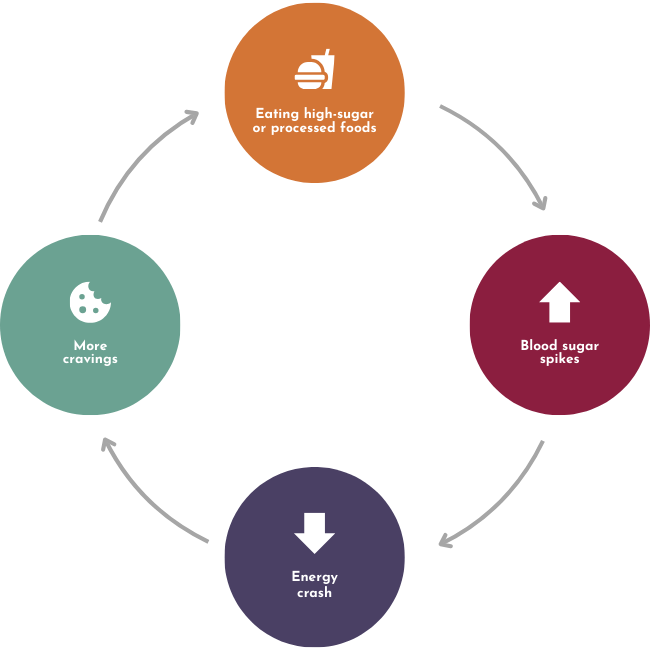Ever wonder why you feel exhausted after meals or get intense cravings for sugar and carbs in the afternoon? These energy highs and lows may not be just about what you’re eating—they’re likely tied to blood sugar swings.
Your body relies on steady blood sugar levels to keep energy balanced, hunger in check, and metabolism functioning properly. But when blood sugar spikes and crashes, it can lead to:
❌ Energy crashes that leave you feeling sluggish
❌ Increased cravings for sugary and processed foods
❌ Disrupted metabolism and a higher risk of insulin resistance
The good news? By making simple changes to how you eat and move, you can stabilize blood sugar, improve energy, and reduce cravings. Let’s dive into the science behind blood sugar swings and how to keep them under control.

Why Blood Sugar Spikes & Crashes Happen
When you eat carbohydrates, your body breaks them down into glucose (sugar) and releases it into the bloodstream. In response, your pancreas releases insulin, which helps move glucose into your cells for energy.
But not all carbs are processed the same way—and this is where blood sugar swings start.
High-Glycemic Foods Cause Rapid Spikes & Crashes
Some foods cause a rapid rise in blood sugar, followed by a crash that leaves you tired, hungry, and craving more sugar. These foods have a high glycemic index (GI), meaning they are digested and absorbed quickly, leading to sharp blood sugar fluctuations.
📌 High-GI Foods That Spike Blood Sugar:
❌ Sugary cereals, white bread, pastries
❌ Soda, juice, and other sweetened beverages
❌ White rice, pasta, and processed snacks
A study in JAMA found that high-GI foods increase hunger and cravings, making it harder to control portion sizes and leading to overeating.

The Hidden Dangers of Blood Sugar Swings
1. Energy Crashes
After a blood sugar spike, insulin brings glucose levels down—but often too quickly, leading to a sudden drop in energy. This crash leaves you feeling:
🚫 Tired & sluggish
🚫 Irritable or foggy-headed
🚫 Craving quick sugar fixes
A study published in The Journal of Endocrinology & Metabolism found that unstable blood sugar is one of the biggest drivers of fatigue and mood fluctuations.
2. Increased Cravings & Hunger
Blood sugar instability messes with hunger hormones like:
- Ghrelin (“the hunger hormone”) – Increases when blood sugar drops, making you feel hungrier.
- Leptin (“the fullness hormone”) – Decreases after blood sugar crashes, leading to less satisfaction from meals.
This leads to a vicious cycle of:

3. Long-Term Metabolic Issues
Frequent blood sugar swings can:
⚠ Weaken insulin sensitivity (leading to higher risk of type 2 diabetes)
⚠ Trigger inflammation & oxidative stress (linked to cardiovascular disease)
⚠ Promote fat storage, especially around the midsection
A 2006 study in JAMA found that erratic blood sugar fluctuations cause more oxidative stress than consistently high blood sugar, making it even more damaging to long-term health.

How to Stabilize Blood Sugar for Better Energy & Fewer Cravings
The key to steady energy and better metabolic health is keeping blood sugar stable throughout the day. Here’s how:
1. Choose Low-Glycemic, Whole Foods
📌 Low-GI foods digest more slowly, providing a steady release of energy without sharp spikes.
✅ Best Foods for Blood Sugar Balance:
- High-fiber carbs – Quinoa, sweet potatoes, whole grains
- Healthy fats – Avocados, nuts, olive oil
- Lean protein – Eggs, fish, chicken, tofu
- Fiber-rich veggies – Leafy greens, broccoli, peppers
🚫 Avoid: Sugary snacks, processed foods, refined grains, and artificial sweeteners.

2. Pair Carbs with Protein & Healthy Fats
Instead of eating carbs alone, combine them with protein and healthy fats to slow digestion and prevent blood sugar spikes.
📌 Smart Meal Combos:
🥑 Whole-grain toast + avocado + eggs
🥗 Grilled salmon + quinoa + leafy greens
🍎 Apple + almond butter
A review in Nutrition, Metabolism & Cardiovascular Diseases found that low-GI meals with balanced macronutrients lead to better blood sugar control and reduced hunger.

3. Move After Meals
Exercise helps your body use glucose efficiently, reducing blood sugar spikes and crashes.
📌 Best Ways to Use Movement for Blood Sugar Control:
✅ Walk for 10–15 minutes after meals – Helps muscles absorb glucose faster.
✅ Strength training – Builds muscle, improving insulin sensitivity.
✅ Low-impact cardio – Swimming, biking, or stretching also help regulate blood sugar.

4. Avoid Skipping Meals
When you go too long without eating, blood sugar drops, making you more likely to overeat at your next meal.
✅ Eat every 3–4 hours to maintain steady energy.
✅ Listen to hunger cues—don’t wait until you’re starving.
✅ Start the day with protein & fiber to set the tone for balanced blood sugar.

The Takeaway: Small Changes, Big Impact
Balancing blood sugar isn’t about cutting carbs or extreme dieting—it’s about making smarter choices that keep energy steady and reduce cravings.
✅ Eat whole, fiber-rich foods instead of processed carbs.
✅ Pair carbs with protein & fats for sustained energy.
✅ Move regularly to improve glucose regulation.
✅ Avoid skipping meals to prevent crashes & cravings.
At Indi, we help you build smarter movement habits to support better energy, metabolism, and long-term health—so you can feel your best every day.
Start feeling more energized today. Try Indi for free!

